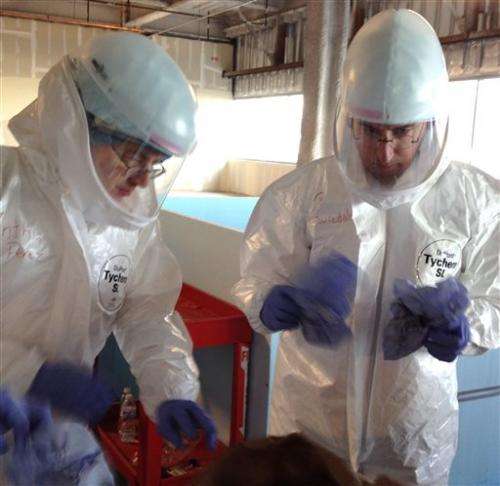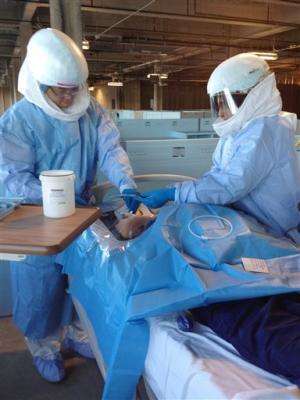Ebola training focuses on astronaut-like gear

The serious-faced physicians practice pulling on bulky white suits and helmets that make them look more like astronauts than doctors preparing to fight a deadly enemy. These training sessions at U.S. hospitals on Ebola alert and for health workers heading to Africa can make the reality sink in: Learning how to safely put on and take off the medical armor is crucial.
"When you're in the real deal, remember to take your time," biosafety expert John Bivona told doctors during a course this week at the University of Chicago's medical center. Suits splashed with patients' vomit or blood must be removed carefully, he explained.
"As much as possible, grab from the inside" to avoid touching contaminated parts of the suits, he said. "Be liberal with disinfectant."
Looking stoic after this week's training, Dr. Mark Nunnally said he's "not overly worried, but I think there's a legitimate concern" that someone with Ebola may arrive at the hospital's door.
An anesthesiologist, he's among about 35 doctors and nurses who've volunteered to treat any Ebola patients who may show up at the Chicago hospital. Nunnally said he volunteered because "somebody has to do it, and I think it's important to give care where there's a need."
The University of Chicago medical staffers get several hours of Ebola training, plus refresher courses and videos in donning and doffing protective gear.
Meanwhile, the federal Centers for Disease Control and Prevention this week started training volunteer health workers heading to Africa to help fight the epidemic.
Dr. David Sugerman, an Emory University emergency room doctor heading soon to Sierra Leone, was among students in a CDC training session Monday in Anniston, Alabama.

Sugerman, who also works for the CDC, said breaches in health workers' protective gear in West Africa have contributed to Ebola's spread.
"You realize going through these exercises how easy that is," he said.
"In Sierra Leone or Liberia or Guinea it's going to be quite hot and humid. And you start sweating. And some of the procedures, like placing an IV, you get pretty nervous with a patient that you know has a high viral load," he said. "Then you get fogged up and you get anxious and you could start pulling at your" equipment, which could be contaminated with virus. "So you have to mentally go through this a number of times and become well-versed. So it becomes a routine."
For U.S. hospitals, the CDC has issued guidance on how to spot suspicious cases and isolate them if necessary, with an emphasis on the importance of asking patients about recent travel to the outbreak region, where more than 3,800 people have died from the disease.
The only person diagnosed with Ebola in the U.S. had traveled from Liberia. When he first sought medical care for a fever and abdominal pain at a Dallas hospital, Ebola wasn't suspected. Hospital officials initially said they didn't know about his travel, but later said that information had been provided and was available to the medical staff caring for him at that time. He was diagnosed with Ebola when he went back to the hospital days later; he died there Wednesday.
"It's so easy to forget to ask about travel," said Dr. Emily Landon, director of a University of Chicago infection control program. "That's our one vulnerability."
Emergency room staffers are trained to focus on the most critical problem, like providing fast treatment for a heart attack or broken leg, she explained. If the same patient also has a fever and headache—common problems but also Ebola symptoms—"it's hard to break that autopilot and say, 'Oh, by the way, did you travel'" recently, Landon said. "We have to get them to break that autopilot every time."
Across town, at Rush University Medical Center, doctors got a frightening test run this past weekend when a man coughing up blood said he had been in contact with someone from Nigeria, one of the countries in West Africa where Ebola spread.
ER staffers donned protective gear and immediately escorted him to a nearby isolation room, but tests showed he had bronchitis, not Ebola, said Dr. Dino Rumoro, Rush's emergency medicine chief.
Rumoro said he's worked through similar scary disease threats—AIDS, SARS, swine flu and smallpox after 9/11—that were in some ways more worrisome because many of them can spread invisibly through the air. Ebola is transmitted through direct contact with blood, vomit and other body fluids, or contact with syringes or other objects contaminated by the virus.
"At least with Ebola we have a fighting chance," Rumoro said, "because I know that it is coming from body fluid and I know if I wear my (protective) suit I'm safe and I know if I don't stick myself with a needle or cut myself with a scalpel I'm safe."
"There's always going to be a little bit of fear in your head," Rumoro said. "But that's OK. That's what keeps us safe."
More information: CDC: www.cdc.gov
© 2014 The Associated Press. All rights reserved.
















